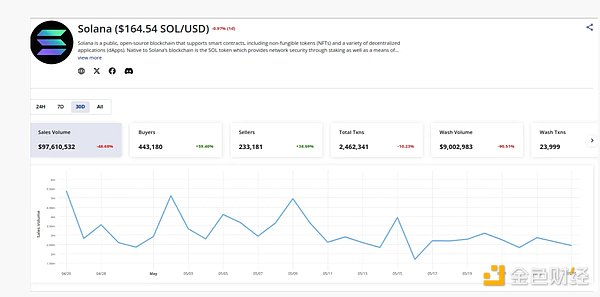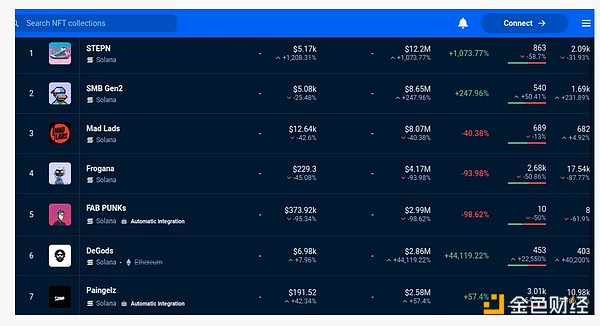Author: Robert John Source: medium Translation: Shan Ouba, Golden Finance
If you’ve been around the cryptocurrency space, you’ve probably heard the buzz about NFTs. These non-fungible tokens have made a splash in the digital world, turning everything from digital art to virtual real estate into valuable assets. But among the many platforms hosting these digital treasures, two names stand out: Solana and Ethereum. So, what’s going on, and why are we comparing these two platforms? Let’s unpack it.
NFT Market Overview
NFTs are unique digital assets verified using blockchain technology. Unlike cryptocurrencies like Bitcoin or Ethereum, which are identical and interchangeable, each NFT is unique. This uniqueness gives NFTs value, making them perfect for representing ownership of digital items like artwork, music, and even tweets.
So, why are NFTs important? They’ve revolutionized the concept of ownership in the digital realm. Artists and creators can now sell their work directly to consumers, without an intermediary, and earn royalties on future sales. This new paradigm provides unprecedented opportunities for digital creators and collectors.
Current Leaders in the NFT Space: Solana and Ethereum
When it comes to platforms that host these NFTs, Ethereum has been the undisputed king. It was the first blockchain to introduce smart contracts, which are essential for creating and trading NFTs. Ethereum’s ecosystem is huge, and many of the most valuable and famous NFTs are hosted on its blockchain.
But wait, there’s a new competitor now – Solana. Over the past month, Solana has made headlines for its explosive growth in the NFT space. Known for its high speed and low transaction fees, Solana has quickly become a favorite among NFT creators and traders. In just 30 days, Solana minted 32 million NFTs, while Ethereum only minted 1 million. This is a staggering gap that clearly shows that Solana is quickly gaining traction.
Creating an NFT collection on Solana is a good idea, as its high transaction speeds and low fees make the minting process efficient and cost-effective. Additionally, Solana’s growing and active community provides a supportive environment for new projects to gain visibility and attention.
Why Does This Comparison Matter?
So why should we care about the competition between Solana and Ethereum? First, understanding the dynamics of the NFT market can provide us with valuable insights into where the industry is headed. It’s not just about which platform is better; it’s about understanding the strengths and weaknesses of each platform and how they meet different needs within the NFT ecosystem.
For example, Ethereum’s established reputation and widespread adoption make it a top choice for high-value NFTs and projects that require strong security. On the other hand, Solana’s speed and low costs make it ideal for creators who need to mint large quantities of NFTs quickly and economically.
Impact on Investors, Creators, and Collectors
For investors, understanding which platform is gaining traction can help make investment decisions. If Solana continues its upward trend, investing in its native token (SOL) could yield strong returns. Similarly, understanding market trends can help collectors make informed choices when purchasing NFTs.
For creators, the choice of platform can significantly impact their reach and profitability. Solana’s low fees mean a larger portion of the sales price goes directly to the creator, which is a huge advantage for many artists. Conversely, Ethereum’s user base and higher sales volume could mean greater exposure and higher prices for their NFTs.
Solana Surpasses ETH
Let’s get straight to the point. If you’ve been following the NFT space closely, you’ll know that something big has been happening recently. Solana has had a stellar run over the past month, surpassing Ethereum in the NFT market. So, how did this happen? Let’s break it down.
Numbers Don’t Lie: Solana’s NFT Boom
First, let’s talk numbers. In the past 30 days, Solana has minted an eye-popping 32 million NFTs. In comparison, Ethereum minted just 1 million NFTs in the same period. Solana is ahead with 31 million NFTs. This isn’t just a small win, it’s a huge leap forward that highlights Solana’s disruptive impact on the NFT market.

The number of NFTs minted by Solana demonstrates its efficiency and speed in handling large-scale operations. Solana’s blockchain is designed to handle thousands of transactions per second, making it a powerful platform for NFT creators who need to mint and manage large amounts of digital assets quickly.
Top Players: Solana’s Notable NFT Collections
Now, let’s focus on some of the top NFT collections that have fueled Solana’s rise. Leading the way are STEPN, SMB Gen2, and Mad Lads. These collections have not only attracted a lot of attention, but also brought in significant trading volume, reinforcing Solana’s dominance in the NFT space.

Interestingly, y00ts and DeGods, two high-profile projects that recently migrated to Solana, did not make the top five collection. This shows that despite the migration of projects to Solana, emerging and homegrown projects are the main force driving the success of the platform. The diversity and activity of Solana’s NFT ecosystem clearly indicates the vitality and expansion of its community.
Ethereum’s response
While Solana has attracted a lot of attention, we also need to look at Ethereum’s response. Despite being surpassed in the number of NFTs created, Ethereum still maintains its advantage in other key areas.
Sales Comparison
Ethereum continues to demonstrate its market strength when we look at sales. Over the past month, Ethereum has seen a staggering $193 million in NFT sales. In comparison, Solana has seen sales of $99 million. This gap shows that despite Solana’s lead in volume, Ethereum’s NFTs continue to trade at higher prices and with greater recognition.
This difference in sales suggests that Ethereum remains the platform of choice for high-value NFT transactions. Ethereum’s reputation, as well as its large network of buyers and sellers, has contributed to these higher sales. This is a reminder that despite Solana’s rapid rise, Ethereum’s dominance in the NFT market is far from diminishing.
Buyer and Seller Dynamics
Another important aspect to consider is the number of active buyers and sellers. Here again, Solana shows its advantage, with significantly more NFT market participants. This increased activity indicates a more active and engaged community, which is critical to continued growth and innovation in the NFT space.
More active participants on Solana means higher liquidity and more opportunities, which is good news for creators and traders. This reflects a vibrant market where NFTs are not only minted in large quantities, but are also actively bought and sold. This level of participation is critical to fostering a healthy and thriving NFT ecosystem.
The Impact of Market Vitality and User Engagement
So, what does this mean for the future of NFTs on Solana and Ethereum? First, Solana’s ability to mint a large number of NFTs and attract a large number of active participants shows that it has an advantage in capturing market share, especially for creators looking for an efficient and cost-effective platform.
On the other hand, Ethereum’s high sales volume emphasizes its continued dominance in terms of value and prestige. Ethereum remains the preferred choice for collectors and investors looking for high-value NFTs. And Solana’s rapid growth and high activity make it an ideal platform for emerging projects.
Price Performance: SOL vs. ETH
Okay, let’s talk about the exciting price performance. Solana (SOL) and Ethereum (ETH) are two of the biggest names in the cryptocurrency space, and their price movements are always eye-catching. Over the past month, SOL has shown impressive upward momentum.
Bull Run for SOL
Over the past 30 days, the price of SOL has increased by 2.5% to $169.30. This rise is not just a random fluctuation, but rather reflects a broader bull trend that has investors buzzing. When a token’s price rises, it usually reflects growing confidence and interest from traders and investors. For SOL, this rise has pushed its market cap to over $76 billion, which is no small feat.
This price increase has also had a positive impact on investor sentiment. The weighted sentiment index, which measures the overall sentiment of investors towards an asset, shows an uptick. More people are talking about SOL, and the sentiment is very positive. This is crucial because market sentiment tends to drive future price movements. When people are optimistic about an asset, they are more likely to buy, further pushing the price higher.
Upcoming Bearish Signal
But wait, it’s not all sunshine. Despite the bull run, there are still some bearish signals to watch out for. According to data from Coinglass, Solana’s long-to-short ratio has declined over the past 24 hours. This ratio is a key indicator of market sentiment and trader behavior. A low ratio indicates that more traders are interested in shorting an asset, meaning they are betting on a price drop.
So, why does this matter? If the trend of a declining long-to-short ratio continues, it could signal a market correction. Traders could start to sell off their holdings, driving prices lower. This is a reminder that despite the excitement of short-term gains, the cryptocurrency market is volatile and trends can change quickly.
Competitive Advantages
Now, let’s dive into what makes Solana different and why it’s attracting so much attention.
Solana’s Strengths: Speed, Scalability, and Community
One of Solana’s biggest strengths is its speed. The blockchain can process thousands of transactions per second, far more than Ethereum’s current capacity. This speed is critical for NFT creators and traders who need to process transactions quickly and efficiently. No one likes waiting for a transaction to complete, especially when dealing with time-sensitive assets like NFTs.
Then there’s the matter of transaction fees. Solana’s fees are significantly lower than Ethereum’s. Lower fees mean more creators and traders are likely to use the platform because it allows them to keep more of their profits. This could be a game changer for those who mint or trade NFTs.
Another factor working in Solana’s favor is its growing and active user base. The more people who use a blockchain, the more active and dynamic the ecosystem becomes. Solana’s community is not only large but also highly engaged, which provides a strong and supportive environment for new and existing projects.
Ethereum’s Enduring Appeal
Despite Solana’s advantages, Ethereum still holds significant advantages in multiple areas. Ethereum has a mature market and a strong infrastructure that has been built and tested over the years. This longevity and reliability has made it the platform of choice for many high-value NFT projects.
Ethereum’s ecosystem is massive, with a plethora of tools, applications, and services that support the creation and trading of NFTs. This infrastructure provides a level of security and reliability that new platforms like Solana are still struggling to achieve.
In addition, Ethereum is in the process of upgrading to Ethereum 2.0, which aims to address some of the scalability and fee issues. These upgrades could make Ethereum more competitive, potentially addressing some of the criticisms that have allowed platforms like Solana to gain traction.
Summary
Despite Solana’s strong performance in the NFT space, Ethereum remains the top choice for many high-value NFT projects due to its solid market position and strong infrastructure. The Ethereum 2.0 upgrade is expected to address its current scalability and fee issues, further solidifying its market position. For new creators and projects looking to enter the NFT market, Solana’s high transaction speeds and low fees offer an attractive option. By creating NFT collections or building a marketplace on Solana, creators and businesses can leverage its technological strengths to achieve efficient and cost-effective operations and engage with an active community to ensure project success.
 JinseFinance
JinseFinance
 JinseFinance
JinseFinance cryptopotato
cryptopotato Bitcoinist
Bitcoinist Bitcoinist
Bitcoinist Coindesk
Coindesk Catherine
Catherine Cointelegraph
Cointelegraph Bitcoinist
Bitcoinist Nulltx
Nulltx Cointelegraph
Cointelegraph